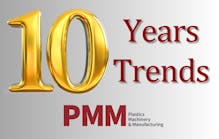Stratasys lands $20 million contract to sell 3D printers to U.S. Navy
By Bruce Geiselman
The U.S. Navy awarded a $20 million contract to Stratasys to provide up to 25 F900 3D printers, plus materials and support, over the next five years.
The first eight printers will be delivered by the end of this year, according to the company. The contract, awarded in late August, indicates that the Navy will pay for the printers as individual orders are issued, according to the U.S. Department of Defense (DOD).
“The benefits of additive manufacturing for military organizations like the U.S. Navy include cost-effectively extending the life of strategic and tactical assets like aircraft while ensuring sustainment activities can happen quickly and from virtually anywhere,” said Mark Menninger, director of the U.S. government and business segment for Stratasys. “This contract, the largest government project for Stratasys to date, continues to expand the presence of industrial 3D printing from Stratasys across the U.S. government.”
In addition to the printers, the $20 million contract includes initial support and maintenance, materials, and development of initial printer training.
The printers will be positioned on Navy bases in the U.S. and Japan and will be used to produce tooling, training aids and parts to maintain a fleet of aircraft across bases worldwide.
Stratasys F900 printers use fused deposition modeling (FDM) technology to build parts by applying a thin bead of thermoplastic resin in successive layers. They use a variety of engineering thermoplastics, each designed to address specific needs and applications, according to Stratasys. Some of the thermoplastics are designed for aerospace parts.
The DOD in January released a report detailing its additive manufacturing strategy. In the report, the DOD stated that manufacturing is undergoing a digital revolution and that additive manufacturing will play a significant role in helping modernize national defense systems.
“AM can be used to build parts that cannot be made any other way; uniquely combine materials; produce obsolete parts; rapidly prototype; [and] create tools and specialized job aids,” according to the report. “AM is a powerful tool to enable innovation and modernization of defense systems, support readiness and enhance warfighter readiness.”
Stratasys, a Minnesota-based 3D printer manufacturer, has previous experience in supplying printers for use with aircraft and defense operations.
For example, according to a case study published last year by Stratasys. U.K.-based BAE Systems has been using additive manufacturing for several years.
The defense and aerospace manufacturer uses four large-scale industrial-grade printers at its Samlesbury, England, site. The first printer was installed in 2014 and the latest was installed in late 2019. It uses the printers for a wide range of applications, including the production of models and design verification prototypes, tools to support manufacturing and end-use parts.
With the availability of a variety of high-performance thermoplastics for the F900, the company can replace traditionally manufactured, typically metal, tools with 3D printed alternatives, according to Stratasys. BAE Systems primarily uses tough engineering plastic, including ASA and ABS, but also is exploring the use of carbon-fiber materials to meet its tooling requirements.
BAE Systems has customers in more than 40 countries, and its business activities include military aircraft production.
Boom Supersonic, an aerospace company headquartered near Denver, is using Stratasys 3D printers in its effort to build a supersonic passenger jet.
Boom initially commissioned two Stratasys printers, an F370 and Fortus 450mc to help with prototyping. It later added a Stratasys F900 printer to expand beyond prototyping into the additive manufacturing of tooling and production parts, according to a Stratasys case study published last year. The company has since printed hundreds of parts and prototypes, according to the case study.
Bruce Geiselman, senior staff reporter
Contact:
Stratasys, Eden Prairie, Minn., 952-937-3000, www.stratasys.com
Bruce Geiselman | Senior Staff Reporter
Senior Staff Reporter Bruce Geiselman covers extrusion, blow molding, additive manufacturing, automation and end markets including automotive and packaging. He also writes features, including In Other Words and Problem Solved, for Plastics Machinery & Manufacturing, Plastics Recycling and The Journal of Blow Molding. He has extensive experience in daily and magazine journalism.






